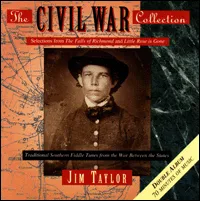THE CIVIL WAR COLLECTION - VOLUME I - LINER NOTES
by Jim Taylor

Following is an excerpt from the The Civil War Collection, Volume 1 Liner Notes by Jim Taylor. It is copyrighted by Jim. He gave me permission to include it here. The liner notes are a very important music history of Quince Dillon, Hugh Dillon and William Dillon.
Additional notes regarding The Civil War Collection by Jim Taylor can be found at Gourd Music.
Quince Dillon's High D / Richmond Blues
Quince Dillon's High D was composed by a Confederate soldier named Quincey Dillion, or at least that's how the name appears on his military service records. A search through those records revealed that Quince first volunteered as a fife player in the 166th Virginia Militia in August of 1861, at Red Sulphur Springs in Monroe County, (West) Virginia. Fife players, along with drummers, were used in Civil War military organizations to give the soldiers a cadence to march by and to lift their spirits when the marches became particularly monotonous and grueling, which was pretty much all the time. The musicians also played a role in the army camps providing musical signals for a variety of camp routines. During battles, the fifers and drummers were often used as aids to the medical staff and sometimes served as stretcher bearers.
Quince's unit, the 166th Virginia Militia, was eventually incorporated into the 59th Virginia Infantry, which along with other Confederate units, was captured at the Battle of Roanoke Island, N.C. on Feb. 8, 1862. Members of the 59th Virginia Infantry who either escaped or where later paroled were reorganized as the 26th Virginia Battalion. Quince Dillon enlisted in this organization in Feb. of 1863 at Centerville, now Greenville, (West) Virginia and promoted to Chief Musician. It is difficult to tell from the record, but it appears as though Quince was present at most of the engagements of the 26th Virginia Battalion from their skirmishes in western Virginia to the large battles of New Market (May 15, 1864), Third Winchester (Sept. 19, 1864), and Cedar Creek (Oct. 19, 1864).
Evidently, Quince Dillion (who was also a gifted fiddler) came from a musical family. The military records show a William Dillion in the 26th Virginia Battalion listed as a private / musician, and also a Hugh Dillion who was recorded as being a fife major in the 23rd Virginia Battlion (which, along with the 26th and 22nd Virginia Battalions, was in Echol's Brigade). Also of interest to me was a document I found in Quince Dillion's file that he had signed with an "X". While it was not uncommon in those days for a man to be illiterate, it does seem odd to me that he could have functioned as a military musician when that position required an almost complete dependence on written notation. Perhaps he just had a really good ear.
At any rate, Quince survived the war and lived well into the 20th century. He was said to be quite a fox hunter in his day, and his "doghorn" still survives. As far as I know, Quince Dillon's High D is the only tune that he composed that has survived down to the present day. The West Virginia banjo version on this recording comes from Sheila Adams.
Richmond Blues refers to a pre-war Richmond militia organization, and can be found in Volume 2 of Knauff's Virginia Reels. The more common title for this tune is My Love, She's But a Lassie Yet. Extremely popular during the Civil War, this Scottish piece was a favorite among military fifers like Quince Dillion.
Quince Dillion's High-D Reel
Following is a link to an audio recording of Henry Reed playing "Quince Dillion's High-D Reel". It was recorded by Alan Jabbour. The recording is located on the website of the Library of Congress.
Henry Reed gave no name to this tune. This tune cannot be traced to other sources. It somehow came to be thought of as a tune Henry Reed learned from Quince Dillion, though there is no concrete evidence of this in the fieldnotes from the 1960s, and it has gone back into circulation among some performers in the old-time music revival under the title "Quince Dillion's High-D Reel". The guitar accompaniment is by Henry Reed's son, Gene.
Audio Recording